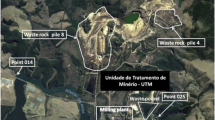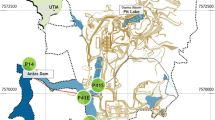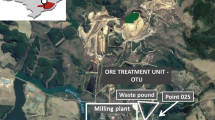Abstract
The Ore Treatment Unit was a uranium mining company that is currently being decommissioned. The local rainfall index makes it necessary to release effluents into the environment. After releasing, the wastewater is available for unrestricted use. Current study aims to use national and international recommendations to assess the radiological potability of released effluents at one of the three points of company’s interface with the environment. Twenty-four samples of water were collected and activity concentrations (AC) were obtained by gross alpha count, gross beta count, and for arsenazo spectrophotometry. Statistical analysis techniques were applied to the data with the purpose of understanding the results for the soluble, particulate, and total fractions. The mean AC for effluents were 3.580, 0.082, 0.103, 0.063, and 0.090 Bq L−1 for Unat, 226Ra, 210Pb, 232Th, and 228Ra, respectively, for the total fraction. The analysis of variance pointed to Unat as a critical radionuclide, since it presented more than 90% of the total AC released into the environment. Pearson’s R2 pointed to soluble fraction as a major contributor to the total AC released. The guidance level proposed by WHO was used to assess the radiological potability of the effluents. The results obtained indicated the need for trigger other analyses. Committed effective dose was estimated due to the unrestricted use of effluents and the value obtained, 0.23 mSv year−1, was below the maximum allowed limit. Finally, the radiotoxicity of the released effluent was evaluated and the value obtained was ~ 50% of the maximum allowed limit. In conclusion, the present study showed that the level of radioactivity released into the environment by the Ore Treatment Unit does not present a radiological risk to the surrounding population.

source terms (mine cave and waste rock pile #4) and water release point (point #076). b A graphical summary of the water circulation before being released into Soberbo river






Similar content being viewed by others
Data Availability
The datasets analyzed during the current study are not publicly available because it becomes unfeasible to make available a very large set of data in a published article. However, the data are accessible through reasonable request to the corresponding author.
References
Al-Masri MS, Al-Akel B, Nashawani A, Amin Y, Khalifa KH, Al-Ain F (2008) Transfer of 40K, 238U, 210Pb, and 210Po from soil to plant in various locations in south of Syria. J Environ Radioact 99(2):322–331. https://doi.org/10.1016/j.jenvrad.2007.08.021
Amaral ECS (1982) Modification of exposure to natural radiation due to agricultural and industrial activities in a high natural radioactivity area in Brazil. Doctoral thesis. Federal University of Rio de Janeiro, (in Portuguese)
Amaral ECS, Azevedo HLP, Mendonca AH (1985) Pre-operational environmental survey at the uranium mine and mill site, Poços de Caldas, Minas Gerais. Brazil Sci Total Environ 42(3):257–266. https://doi.org/10.1016/0048-9697(85)90061-0
Amaral RS, Vasconcelos WE, Borges E, Silveira SV, Mazzilli BP (2005) Intake of uranium and radium-226 due to food crops consumption in the phosphate region of Pernambuco-Brazil. J Environ Radioact 82(3):383–393. https://doi.org/10.1016/j.jenvrad.2005.02.013
Annamalai SK, Arunachalam KD, Selvaraj R (2017) Natural radionuclide dose and lifetime cancer risk due to ingestion of fish and water from fresh water reservoirs near the proposed uranium mining site. Environ Sci Pollut Res 24(18):15427–15443. https://doi.org/10.1007/s11356-017-9111-5
Arnold M, Kangas P, Mäkinen A, Lakay E, Isomäki N, Lavén G, Gericke M, Pajuniemi P, Kaartinen T, Wendling L (2019) Mine water as a resource: selective removal and recovery of trace antimony from mine-impacted water. Mine Water Environ 38(2):431–446. https://doi.org/10.1007/s10230-019-00597-2
Attallah MF, Hilal MA, Moussa SI (2017) Quantification of some elements of nuclear and industrial interest from zircon mineral using neutron activation analysis and passive gamma-ray spectroscopy. Appl Radiat Isot 128:224–230. https://doi.org/10.1016/j.apradiso.2017.07.018
Attallah MF, Abdelbary HM, Elsofany EA, Mohamed YT, Abo-Aly MM (2020) Radiation safety and environmental impact assessment of sludge TENORM waste produced from petroleum industry in Egypt. Process Safety and Environmental Protection 142:308–316. https://doi.org/10.1016/j.psep.2020.06.012
Azevedo HLP, Amaral ECS, Godoy JM (1988) Evaluation of the 226Ra transport by river sediments surrounding the Brazilian uranium mining and milling facilities. Environ Pollut 51:259–268. https://doi.org/10.1016/0269-7491(88)90166-2
Barcellos C, Amaral ECS, Rochedo E (1990) Radionuclide transport by Poços de Caldas Plateau rivers, Brazil. Environ Technol 11:533–540. https://doi.org/10.1080/09593339009384894
Boniolo MR (2016) Uranium removal from waters of acid drainage of mines by biosorption techniques, Doctoral thesis. Paulista State University (in Portuguese)
Brasil (1986) CONAMA (National Environment Council). 1986. Rule nº 1, January 23th 1986. Published in DOU, February 17th. Brasilia: DOU (in Portuguese)
Brasil (2017) Ministry of Health. Portaria Consolidação nº 5. PUBLICADO NO DOU EM: 03/10/2017 | EDIÇÃO: SUPLEMENTO 190 | SEÇÃO: 1 | PÁGINA: 360. Brasília: Brasil. Ministério da Saúde, Governo Federal. Brasilia: DOU. (in Portuguese)
Campos MJ, Penna-Franca E, Lobao N, Trindade H, Sachett I (1986) Migration of radium from the thorium ore deposit of Morro do Ferro, Poços de Caldas. Brazil J Environ Radioact 3(2):145–161. https://doi.org/10.1016/0265-931X(86)90033-0
Cipriani M (2002) Mitigation of social and environmental impacts due to definitive closure of uranium mines. Doctoral thesis. Campinas State University (in Portuguese)
CNEN (1973) National Nuclear Energy Commission. Basic Standards for Radiological Protection. Rio de Janeiro (in Portuguese)
CNEN (2011) National Nuclear Energy Commission. Dose coefficients for public exposure. PR 3.01/011:2011 Rio de Janeiro: CNEN. (in Portuguese).
CNEN (2014) National Nuclear Energy Commission. Basic guidelines for radiation protection. Rio de Janeiro: CNEN. (in Portuguese).
D’souza TJ, Mistry KB (1970) Comparative uptake of thorium-230, radium-226, lead-210 and polonium-210 by plants. Radiat Bot 10(3):293–295. https://doi.org/10.1016/S0033-7560(70)80024-2
El-Didamony H, Ali MM, Awwad NS, Attallah MF, Fawzy MM (2013) Radiological characterization and treatment of contaminated phosphogypsum waste. Radiochemistry 55(4):454–459. https://doi.org/10.1134/S106636221304019X
EURATOM (2013) European Atomic Energy Community. No. 2013/51 laying down requirements for the protection of the health of the general public with regard to radioactive substances in water intended for human consumption. Geneve
Fathabadi N, Salehi AA, Naddafi K, Kardan MR, Yunesian M, Nodehi RN, Deevband MR, Shooshtari MG, Hosseini SS, Karimi M (2017) Radioactivity levels in the mostly local foodstuff consumed by residents of the high level natural radiation areas of Ramsar, Iran. J Environ Radioact 169:209–213
Fernandes HM, Franklin MR, Veiga LH (1998) Acid rock drainage and radiological environmental impacts. A study case of the uranium mining and milling facilities at Poços de Caldas. Waste Manage. 18(3):169–181. https://doi.org/10.1016/S0956-053X(98)00019-1
Ferrari RC (2010) Assessment of the environmental consequences due to radioactive effluents from uranium mining on the physical, chemical and diversity characteristics of the zooplankton community in the Mineral Ore Treatment Unit, Antas dam and Bortolan dam, Poços de Caldas, MG. Dissertation. University of Sao Paulo. (in Portuguese)
Ferrari CR, Nascimento HAF, Rodgher S, Almeida T, Bruschi AL, Nascimento MRL, Bonifácio RL (2017) Effects of the discharge of uranium mining effluents on the water quality of the reservoir: an integrative chemical and ecotoxicological assessment. Sci Rep 7(1):1–10. https://doi.org/10.1038/s41598-017-14100-w
Ferreira DF (2018) Multivariate statistics, UFLA, 3º ed. (in Portuguese).
Franklin MR (2007) Numerical modeling of the hydrological flow and the geochemical processes applied to the prevision of the acid drainage in a sterile pile of the Poços de Caldas uranium mine - MG. Doctoral thesis. Federal University of Rio de Janeiro (in Portuguese).
Galhardi JA, Mello JW, Wilkinson KJ (2020) Bioaccumulation of potentially toxic elements from the soils surrounding a legacy uranium mine in Brazil. Chemosphere 261:127679. https://doi.org/10.1016/j.chemosphere.2020.127679
Giri S, Singh G, Jha VN, Tripathi RM (2011) Risk assessment due to ingestion of natural radionuclides and heavy metals in the milk samples: a case study from a proposed uranium mining area. Jharkhand Environ Monit Assess 175(1–4):157–166. https://doi.org/10.1007/s10661-010-1502-8
Godoy JM, Lauria DC, Godoy ML, Cunha R (1994) Development of a sequential method for determination of 238U, 234U, 232Th, 230Th, 228Th, 228Ra, 226Ra, and 210Pb in environmental samples. J Radioanal Nucl Chem 182:165–169. https://doi.org/10.1007/BF02047980
Guilhen SN, Cotrim MEB, Sakata SK, Scapin MA (2019) Application of the fundamental parameter method to the assessment of major and trace elements in soil and sediments from Osamu Utsumi uranium mine by WDXRF. REM-Int Eng J 72(4):609–617. https://doi.org/10.1590/0370-44672018720146
Haakonde T, Yabe J, Choongo K, Chongwe G, Islam MS (2020) Preliminary assessment of uranium contamination in drinking water sources near a uranium mine in the Siavonga District, Zambia, and associated health risks. Mine Water Environ. 39:735–745. https://doi.org/10.1007/s10230-020-00731-5
IAEA (1967) International Atomic Energy Agency. Basic Safety Standards for Radiation Protection. Safety series nº 9. Vienna
IAEA (1996) International Atomic Energy Agency. International basic safety standards for protection against ionizing radiation and for the safety of radiation sources, IAEA safety standards series nº 115. Vienna
IAEA (2014) International Atomic Energy Agency. Radiation protection and safety of radiation sources: international basic safety standards. IAEA safety standards series. Vienna
IAEA (2018) International Atomic Energy Agency.Radiation protection of the public and the environment. Vienna
IBGE, 2020. Instituto Brasileiro de Geografia e Estatística. Cidades e Estados. Caldas. 2020. Accessed on Jan. 11th, 2021. Available in: https://www.ibge.gov.br/cidades-e-estados/mg/caldas.html?
ICRP (1959) International Commission on Radiological Protection. Recommendations of the International Commission on Radiological Protection. ICRP Publication 1. Pergamon Press, New York
ICRP (1960) International Commission on Radiological Protection. Report of committee II on permissible dose for internal radiation. Pergamon Press, London
ICRP (1966) International Commission on Radiological Protection. Recommendations of the International Commission on Radiological Protection. ICRP Publication 9. Pergamon Press, Oxford
ICRP (1992) International Commission on Radiological Protection. Age-dependent doses to members of the public from intake of radionuclides. ICRP Publication 67.
ICRP (2006) International Commission on Radiological Protection. Assessing dose of the representative person for the purpose of the radiation protection of the public. ICRP Publication 101a.
ICRP (2007) International Commission on Radiological Protection. Recommendations of the international commission on radiological protection. ICRP Publication 103. New York
Lauria DC, Rochedo ERR, Godoy MLDP, Santos EE, Hacon SS (2012) Naturally occurring radionuclides in food and drinking water from a thorium-rich area. Radiat Environ Biophys 51:367–374. https://doi.org/10.1007/s00411-012-0428-7
Minitab (2007) Minitab statistical software. State College, Pennsylvania
Moreira FHDS, Alberti HLC, Taddei MHT, Silva NC, Fleming PM (2018) A comparative study of methods for determining the concentration of radon-222 in spring waters in Poços de Caldas Plateau, Brazil. Revista Águas Subterrâneas (ABAS) 32(1):114–120. https://doi.org/10.14295/ras.v32i1.28973
NRC (2000) Nuclear Regulatory Commission. Radionuclides rule. Wasington
Pereira W, Kelecom A, Pereira J, Py Júnior D (2014) Release of uranium by an ore treatment unit at Caldas, MG. Brazil J Environ Protect 4(6):570–574. https://doi.org/10.4236/jep.2013.46066
Pereira W, Kelecom A, Lopes JM, do Carmo AS, Júnior DDAP, Silva AX (2020) Evaluation of the radiological quality of water released by a uranium mining in Brazil. Environ Sci Pollut Res. 27(29):36704–36717. https://doi.org/10.1007/s11356-020-09672-6
Pereira WS, Lopes JM, Kelecom A, Garcêz RW, Silva AX, Dam RS, Paiva AK (2021) Lifetime cancer risk increase due to consumption of some foods from a high background radiation area. Appl Radiat Isot 176:109855. https://doi.org/10.1016/j.apradiso.2021.109855
Pereira WS, Kelecom AG, Silva AX, Carmo AS, Py Júnior DA (2018) Assessment of uranium release to the environment from a disabled uranium. J Environ Radioact, 118:18–22. https://doi.org/10.1016/j.jenvrad.2017.11.012
Pereira WS, Kelecom A, Lopes JM, do Carmo AS, Espindola CB, Campelo EL, Lamego F, Silva AX (2021a) Radiological quality of wastewater released from a waste dam containing natural radionuclides. J Radioanal Nucl Chem 1–15. https://doi.org/10.1007/s10967-021-07973-9
Rodgher S, Azevedo H, Ferrari CR, Roque CV, Ronqui LB, Campos MB, Nascimento MRL (2013) Evaluation of surface water quality in aquatic bodies under the influence of uranium mining (MG, Brazil). Environ Monit Assess 185:2395–2406. https://doi.org/10.1007/s10661-012-2719-5
Rosner B (2016) Fundamentals of biostatistic. ed. Cengage Learning, Boston
Santos EE, Lauria DC, Amaral ECS, Rochedo ER (2002) Daily ingestion of 232Th, 238U, 226Ra, 228Ra and 210Pb in vegetables by inhabitants of Rio de Janeiro city. J Environ Radioact 62:75–86. https://doi.org/10.1016/S0265-931X(01)00152-7
Savvin SB (1961) Analytical use of arsenazo III: determination of thorium, zirconium, uranium and rare earth elements. Talanta 8:673–685. https://doi.org/10.1016/0039-9140(61)80164-1
Savvin SB (1964) Analytical applications of arsenazo III—II: determination of thorium, uranium, protactinium, neptunium, hafnium and scandium. Talanta 11:1–6. https://doi.org/10.1016/0039-9140(64)80003-5
Silva LB (2020) Committed effective dose and estimated incidence of cancer due to ingestion of 40K, 226Ra, 228Ra and 228Th in grains of the Poços de Caldas City population diet. Masters Dissertation. Federal University of Rio de Janeiro. (in Portuguese)
Silva LB, Lopes JM, Pereira WS, Garcêz RWD, Silva AX, Talhofer JL (2021) Committed effective dose and lifetime cancer risk due to ingestion of natural radionuclides in grains grown in an area of high background radiation. Appl Radiat Isot 172:109656. https://doi.org/10.1016/j.apradiso.2021.109656
Souza, A.M., Silveira, C.C., Pereira, R.M., (2013). Contribution of metals from the waste piles of the Osamu Utsumi mine to drain the alkaline complex of Poços de Caldas City, Minas Gerais. Geochim. Bras. 27, 63-76 (in Portuguese). https://doi.org/10.5327/Z0102-9800201300010006
Tauhata L, Vianna MECM, De Oliveira AE, Ferreira AC, Bragança MJC, Clain AF, De Faria RQ (2006) The Brazilian National Intercomparison Program (PNI/IRD/CNEN): evaluation of 15 years of data. J Environ Radioact 86(3):384–390. https://doi.org/10.1016/j.jenvrad.2005.10.002
USEPA (1997) United States Environmental Protection Agency. Exposure factors handbook. Washington
USEPA (1999) United States Environmental Protection Agency. Cancer risk coefficients for environmental exposure to radionuclides. Federal Guidance Report No. 13. Washington
Valentin JL (2012) Numerical ecology - an introduction to multivariate analysis of ecological data. Interciência, Rio de Janeiro. (in Portuguese).
Veiga LH, Koifman S, Melo VP, Sachet I, Amaral EC (2003) Preliminary indoor radon risk assessment at the Poços de Caldas Plateau, MG – Brazil. J Environ Radioact 70:161–176. https://doi.org/10.1016/S0265-931X(03)00101-2
Vianna MECM, Tauhata L, de Oliveira AE, de Oliveira JP, Clain AF, Ferreira ACM (1998) Evaluation of Brazilian intercomparison program data from 1991 to 1995 of radionuclide assays in environmental samples. Appl Radiat Isot 49(9–11):1463–1466. https://doi.org/10.1016/S0969-8043(97)10093-8
WHO (2006) World Health Organization. Guidelines for drinking-water quality: incorporating first addendum. Geneva
WHO (2011) World Health Organization. Guidelines for drinking-water quality. 4th Ed, Geneva
WHO (2017) World Health Organization. Guidelines for drinking-water quality: fourth edition incorporating the first addendum.
WHO (2018) World Health Organization. Management of radioactivity in drinking-water. Geneva
Author information
Authors and Affiliations
Contributions
WSP: conceptualization, data curation, formal analysis, methodology, software, writing—original draft.
AK: conceptualization, supervision, writing—review and editing.
MCP: software, writing—review and editing.
JML: conceptualization, data curation, writing—review and editing.
ELCC: conceptualization, writing—review and editing.
CBE: writing—review and editing.
ASC: writing—review and editing.
DAPJ: conceptualization, data curation.
SQP: writing—review and editing.
AXS: project administration, resources, supervision.
Corresponding author
Ethics declarations
Ethics approval and consent to participate
Not applicable.
Consent for publication
Not applicable.
Competing interests
The authors declare no competing interests.
Additional information
Responsible Editor: Georg Steinhauser
Publisher's note
Springer Nature remains neutral with regard to jurisdictional claims in published maps and institutional affiliations.
Rights and permissions
About this article
Cite this article
Pereira, W.S., Kelecom, A., Charles-Pierre, M. et al. Assessment of released natural radionuclides by waste rock pile and mining pit associated with a uranium mine at Caldas, Minas Gerais, Brazil. Environ Sci Pollut Res 29, 58065–58077 (2022). https://doi.org/10.1007/s11356-022-19887-4
Received:
Accepted:
Published:
Issue Date:
DOI: https://doi.org/10.1007/s11356-022-19887-4




